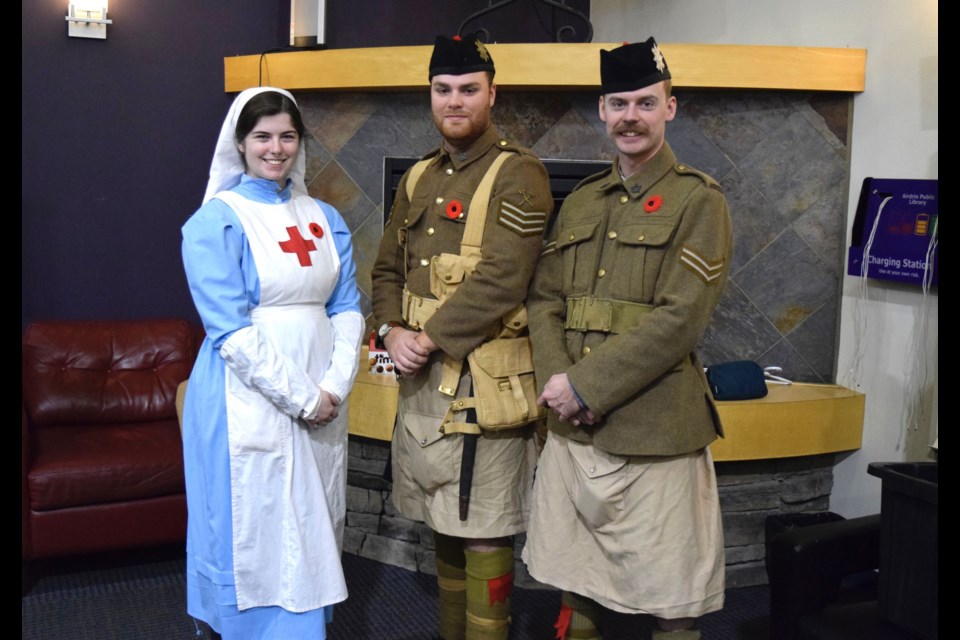In the fall of 1914 and into the early winter of 1915, soldiers of the Royal Highland Regiment of Canada disembarked in France. Their destination was the western front of the First World War, where the Regiment, commonly referred to as The Black Watch, would be posted until the war’s conclusion in 1918.
On November 2, 2024, in one isolated corner of the Airdrie Public Library (APL), members of The Black Watch dug in.
Stationed behind a collapsible plastic table adorned with entrenching tools, medical equipment, and thick wool coats, soldiers of the Royal Highland Regiment armed themselves with info packets printed on thick cardstock. Instead of preparing to go over the top, they prepared to field questions from interested observers.
They were, of course, re-enactors. Three members of the Alberta World War Living History Association (AWWLHA) had come to the Library to educate and inform. As a living symbol of remembrance, the AWWLHA attempts to personalize the aspects of living history and to tell it through a first-person perspective.
Marcus Nielsen has been an association member since its founding four years ago. He was in the cadets during his youth and has always had a passion for history and learning.
Dressed head to toe in an authentic Black Watch uniform, complete with brownish wool coat and knee length kilt, Nielsen said AWWLHA wants to teach people about history.
"This is a great way to embrace a bit more and get a better understanding of what those men one hundred years ago went through,” he said. "You can read a lot of books and watch a lot of movies but...hopefully [this] gives a new insight [and makes you] think, 'Hey this really sucked' and to gain a new appreciation for that, because it's something that can be lost easily."
Nielsen and his Black Watch re-enactment compatriot Galen March said they try to make their reenactment as accurate as possible. March, who was also in cadets as a kid, said their group found diaries of men who served in the Royal Highland Regiment, and that what they found in those pages serves as background for a lot of their re-enactment.
"Being able to put [up] that human side as opposed to just reading a page on a document ... there is a personal touch," March said. "Yes, they were human. They went out there and had their own lives; it wasn't just war."
The APL worked with AWWLHA to set up a sort of living history exhibit. Throughout the day library users could come up and ask questions to the re-enactors and learn about the history they were portraying.
March said having interactions with people who want to learn history gives a more human side to the conflict. To see and interact with someone portraying a soldier is a powerful reminder that the person they’re portraying could have been their own relative, March said.
Portraying one of Canada’s Nursing Sisters, some of the less remembered figures of the First World War, Taylor O’Sullivan said that re-enactment helps history come alive.
“You get to see how poor the living conditions really were,” she said. “You wouldn’t be able to see that while reading about it. You’re like, ‘Wow, that was horrible,’ but actually seeing it physically in front of you…it brings it to life.”
Every summer the AWWLHA puts on a re-enactment of a First World War battle. The Summer Skirmish, as the event is called, brings together AWWLHA members from across the province.
"We try to make [the re-enactments] as accurate as possible so when people come and ask questions it's like a glimpse into the past for them,” Nielsen said. “This is just our way to keep the memory alive and to show people that this is what 100 years ago would have been like."
March added that the act of remembrance is a guiding principle for the members of the AWWLHA. In his coat pocket, March carries around a primitive-looking soldier identification number-- a dog tag. The small signifier fits in the palm of March’s hand. The service number stamped was the real identification for a Royal Highland Regiment Lance Corporal who died at the Second Battle of Ypres.
“Yes this person lived, they happened,” march said. “There isn't a whole lot of their records left from the war, so being able to piece that together is really impactful."




